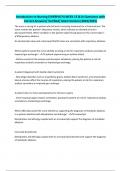Introduction to Nursing (SHERPATH) WEEK 13 &14-Questions with
Correct Answers/ Verified/ latest Version (2024/2025)
The nurse is caring for a patient who fell and is receiving treatment for a fractured arm. The
nurse reviews the patient's laboratory results, which indicate an elevated pH and a
decreased PaCO2. Which condition is the patient experiencing based on the current data? -
✔✔Respiratory alkalosis
An elevated pH value and a decreased PaCO2 value are consistent with respiratory alkalosis.
Which patients would the nurse identify as being at risk for respiratory acidosis secondary to
impaired gas exchange? - ✔✔A patient experiencing an asthma attack
- Asthma constricts the airways and decreases exhalation, placing the patient at risk for
respiratory acidosis secondary to impaired gas exchange.
A patient diagnosed with Guillain-Barré syndrome
- Neurologic disorders such as myasthenia gravis, Guillain-Barré syndrome, and amyotrophic
lateral sclerosis affect the muscles of respiration, placing the patient at risk for respiratory
acidosis secondary to impaired gas exchange.
A patient who is 2 hours postoperative for thoracic surgery
- Chest trauma/surgery impairs ventilation, placing the patient at risk for respiratory acidosis
secondary to impaired gas exchange.
Which ABG data would the nurse identify as supporting the diagnosis of metabolic alkalosis
in a patient admitted with dehydration and lethargy? - ✔✔Increased pH
Dehydration and lethargy coupled with an increased pH support the diagnosis of metabolic
alkalosis.
Increased bicarbonate
Dehydration and lethargy coupled with an increased bicarbonate level support the diagnosis
of metabolic alkalosis.
,Which acid-base imbalance would the nurse anticipate in a patient after a motor vehicle
accident in which the steering wheel hit the patient's chest and trapped the patient in the
car until rescue workers arrived? - ✔✔Respiratory acidosis
Trauma to the chest decreases ventilation and impairs gas exchange, placing the patient at
risk for respiratory acidosis.
Which conditions in the medical history would the nurse identify as a risk factor for
metabolic acidosis? - ✔✔Type I diabetes
Type I diabetes can cause ketoacidosis, which leads to acid accumulation and metabolic
acidosis.
Sepsis
In sepsis, lack of oxygen available to the cells results in anaerobic metabolism and the
accumulation of lactic acid.
Which data in the medical history of a patient who is awake, but lethargic, and taking rapid,
deep breaths would the nurse suspect as the cause of the following laboratory values: pH
7.31, PaO2 59.2 mm Hg, PaCO2 38.6 mm Hg, HCO3- 17.5 mEq/L, and oxygen saturation
88%? - ✔✔Diabetes mellitus
The pH and HCO3- values indicate metabolic acidosis, and the Kussmaul respirations are
consistent with diabetic ketoacidosis.
Which change in respiratory pattern observed in a type I diabetic patient with metabolic
acidosis indicates to the nurse that compensation is occurring? - ✔✔Kussmaul respirations
Kussmaul respirations remove excess carbon dioxide from the system. This is an indication
of compensation.
Which hypotheses would the nurse consider when handed over a patient with an acid-base
imbalance who has Kussmaul respirations and is reported to be hypotensive and
dysrhythmic? - ✔✔Excess acid production
Excess acid production is associated with hypotension and dysrhythmias as well as Kussmaul
respirations.
, Which additional cues would the nurse expect when caring for a patient with Acute
Confusion associated with respiratory alkalosis? - ✔✔Muscle cramping
- Hyperventilation can cause muscle cramping as a result of hypocalcemia. This respiratory
alkalosis is also associated with tachypnea, lightheadedness, numbness and tingling of
extremities, paresthesia, palpitations, cardiac dysrhythmias, anxiety, restlessness, and
decreased level of consciousness.
Restlessness
- Hyperventilation can be associated with restlessness and is also associated with tachypnea,
lightheadedness, numbness and tingling of extremities, paresthesia, muscle cramping,
palpitations, cardiac dysrhythmias, anxiety, and decreased level of consciousness.
Tachypnea
- Acute Confusion with respiratory alkalosis is associated with tachypnea or
Hyperventilation. It is also associated with lightheadedness, numbness and tingling of
extremities, paresthesia, muscle cramping, palpitations, cardiac dysrhythmias, anxiety,
restlessness, and decreased level of consciousness.
The nurse is caring for a patient with dyspnea and impaired gas exchange secondary to
chest injury causing respiratory acidosis. Which evaluation would the nurse include in the
plan of care to specifically monitor a goal of returning blood pressure to baseline or within
normal limits (WNL) within 24 hours of admission? - ✔✔Vital signs
- Vital signs would provide blood pressure readings to confirm that the goal has been
reached.
An older adult patient with a history of tobacco use reports fatigue, decreased energy, and
difficulty breathing. The hypothesis includes Impaired Gas Exchange with respiratory
acidosis. Which goal statement specific for fatigue would the nurse include in the plan of
care? - ✔✔Patient will verbalize feelings of increased energy within 24 hours of admission.
- This goal is specific, measurable, and related to fatigue.
Which solutions are appropriate for a nurse to include in the plan of care for a diabetic
patient with metabolic acidosis? - ✔✔Decrease blood sugar




